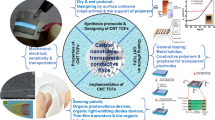Abstract
Single walled-carbon nanotube (SWCNT) thin film is one of the candidates for the next-generation flexible and transparent conductive thin film, which is a crucial component in various applications such as electrodes of flat-panel displays, solar cells, light emitting diodes, and touch panels. An intensive research work is underway to develop thin and flexible SWCNT films. The most important requirement of an SWCNT thin film is that it should show a low sheet resistance coupled with a high transparency. In this work, thin films of SWCNTs are prepared by vacuum filtration. The electrical properties of the as-prepared, annealed and HNO3-treated SWCNT films have been investigated. It is found that the square resistance can be significantly changed upon anneal and HNO3-treatment. A room-temperature ethanol alcohol sensor based on the SWCNT film has also been demonstrated.
Similar content being viewed by others
References
Hu L, Hecht D S, Gruner G. Percolation in transparent and conducting carbon nanotube networks. Nano Letters, 2004, 4(12): 2513–2517
Yao Z, Kane C L, Dekker C. High-field electrical transport in single-wall carbon nanotubes. Physical Review Letters, 2000, 84(13): 2941–2944
Javey A, Kim H, Brink M, Wang Q, Ural A, Guo J, McIntyre P, McEuen P, Lundstrom M, Dai H. High-κ dielectrics for advanced carbon-nanotube transistors and logic gates. Nature Materials, 2002, 1(4): 241–246
Green A A, Hersam M C. Colored semitransparent conductive coatings consisting of monodisperse metallic single-walled carbon nanotubes. Nano Letters, 2008, 8(5): 1417–1422
Wu Z C, Chen Z H, Du X, Logan J M, Sippel J, Nikolou M, Kamaras K, Reynolds J R, Tanner D B, Hebard A F, Rinzler A G. Transparent, conductive carbon nanotube films. Science, 2004, 305(5688): 1273–1276
Blighe F M, Hernandez Y R, Blau W J, Coleman J N. Observation of percolation-like scaling—far from the percolation threshold—in high volume fraction, high conductivity polymer-nanotube composite films. Advance Materials, 2007, 19(24): 4443–4447
Snow E S, Perkins F K, Houser E J, Badescu S C, Reinecke T L. Chemical detection with a single-walled carbon nanotube capacitor. Science, 2005, 307(5717): 1942–1945
Penza M, Cassano G, Rossi R, Rizzo A, Signore M A, Alvisi M. Effect of growth catalysts on gas sensitivity in carbon nanotube film based chemiresistive sensors. Applied Physics Letters, 2007, 90(10): 103101
Author information
Authors and Affiliations
Corresponding author
Rights and permissions
About this article
Cite this article
Zhao, Y., Mo, Q. Electrical properties of transparent conducting carbon nanotube films. Front. Optoelectron. China 2, 425–428 (2009). https://doi.org/10.1007/s12200-009-0076-y
Received:
Accepted:
Published:
Issue Date:
DOI: https://doi.org/10.1007/s12200-009-0076-y




